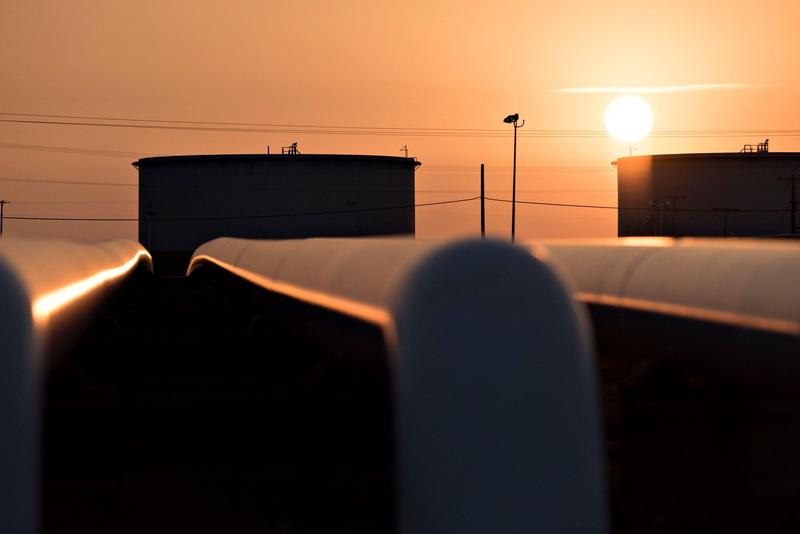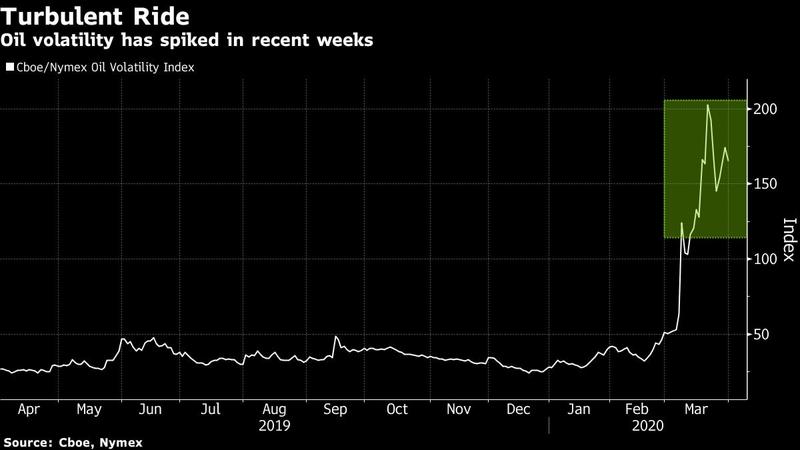 The sun rises beyond oil storage tanks at the Enbridge Inc. Cushing storage terminal in Cushing, Oklahoma, US, on March 25, 2015. (DANIEL ACKER / BLOOMBERG)
The sun rises beyond oil storage tanks at the Enbridge Inc. Cushing storage terminal in Cushing, Oklahoma, US, on March 25, 2015. (DANIEL ACKER / BLOOMBERG)
Oil was rooted near US$20 a barrel as President Donald Trump’s pledge to meet with feuding producers Saudi Arabia and Russia to support the market failed to bolster prices after their worst ever quarter.
Saudi Arabia showed no sign of bowing to pressure from Trump to dial back the oil-price war with Russia as the kingdom pushed crude supply to record levels.
Trump said last night he’d spoken to both President Vladimir Putin and Crown Prince Mohammed bin Salman in an effort to broker a truce between the world’s two largest oil exporters. But Saudi Arabia started the month by boosting supply to more than 12 million barrels a day, the largest on record.
So far, Riyadh has insisted that it will only back away from a decision to flood the global market if all the world’s leading producers - including the US - agree to cut output. Russia, meanwhile, struck a more conciliatory tone without offering any concrete proposals.
Futures crashed 66% in the first three months of the year as the coronavirus destroyed demand and the world’s biggest producers embarked on a catastrophic supply free-for-all. Prices extended losses on Wednesday even after Trump said he discussed the collapse with his Russian and Saudi counterparts, adding that Moscow and the kingdom would “get together” to seek a solution. Any agreement to cut output is likely too late and would fall short of the loss in consumption, according to Goldman Sachs Group Inc.
Prices extended losses on Wednesday even after Trump said he discussed the collapse with his Russian and Saudi counterparts, adding that Moscow and the kingdom would “get together” to seek a solution
A senior official said that while they hadn't spoken to Saudi Arabia yet, Moscow had no plans to increase production given the current market situation. He gave no indication that Russia was willing to consider production cuts, however. It was Russia’s refusal to join Saudi Arabia and other OPEC producers in deeper reductions that kicked off the price war in early March.
Trump’s decision to wade into oil diplomacy is driven by the catastrophic impact of the oil price crash on the American shale industry, largely based in Texas and other Republican-leaning states. But his mission to rein in global supply is overshadowed by the unprecedented loss of demand caused by fight against the coronavirus.
World oil demand, normally around 100 million barrels a day, will likely be down by 30 millions barrels a day in April and has yet to bottom out as lockdowns due to the virus continue, Chris Bake, an executive committee member at trader Vitol said on Tuesday.
The outlook for oil looks terrible, with oil facing a potentially apocalyptic April, according to top industry analysts. Iraq has pledged to boost its output this month, while US industry data is signaling the biggest weekly increase in American stockpiles since 2017.
“The possibility of negotiations is offering a rare ray of light to a heavily beleaguered market,” said Howie Lee, a Singapore-based analyst at Oversea-Chinese Banking Corp. “There are too many uncertainties involved to determine how strong a driver this would be, but it would probably take more than output cuts to lift prices back to pre-crash levels.”
The physical oil market continued to show deepening strain. Dated Brent, the benchmark for two-third of the world’s real oil supply, was assessed at US$17.675 on Tuesday, down 11.5 cents from Monday when it was already the lowest price since 2002. Across major shale regions in Texas and North Dakota, oil has dropped below US$10 a barrel, while some lesser known grades have posted negative prices.
READ MORE: Oil prices surges amid Saudi oil crisis
While Trump said he would join in a meeting with the former OPEC+ allies “if need be,” the first wave of crude from Saudi Arabia is already on its way toward Europe and the US as it escalates its price war with Russia. The flood comes at a precarious time for the market, with daily oil consumption possibly dropping by as much as 22 million barrels in April from a year earlier as lockdowns across the world due to the virus outbreak dents demand.
An output agreement between the US and OPEC+ including Canada would be difficult to reach, but signs of policy discussions are multiplying and an outcome should no longer be dismissed, according to Goldman. The bank predicts the crash in consumption will create a surplus of 14 million barrels a day in the second quarter, piling pressure on swelling storage tanks.

ALSO READ: Oil prices plunge a third after Saudi Arabia starts output war
The Russian official said it made no sense for producers to boost output in the current situation. Energy Minister Alexander Novak said last month Russia can raise prodution by 200,000 to 300,000 barrels a day in the short term, and by as much as 500,000 barrels a day in the near future. That’s a fraction of the additional volume Saudi Arabia has pledged to pump.
On Tuesday evening in Washington, Trump said the US would meet with Saudi Arabia and Russia with the goal of staunching the historic plunge in oil prices.
Trump said he's raised the issue with Russian Putin and Mohammed bin Salman. “They're going to get together and we're all going to get together and we’re going to see what we can do,” he said. "The two countries are discussing it. And I am joining at the appropriate time, if need be.”
US Energy Secretary Dan Brouillette and Novak, his Russian counterpart, had a “productive discussion” on Tuesday and agreed to “continue dialog among major energy producers and consumers, including through the G20,” the Department of Energy said in a statement. The agency did not detail any steps the nations are considering to stem the downturn.


